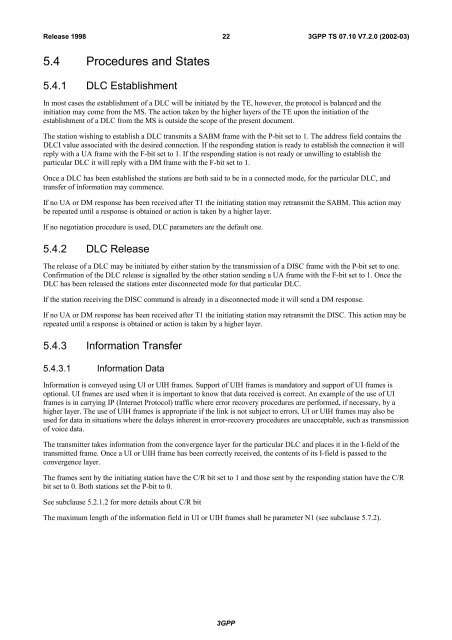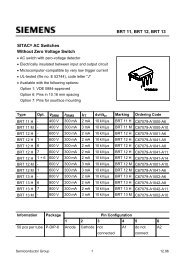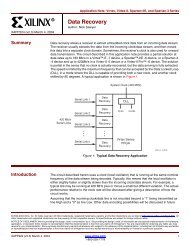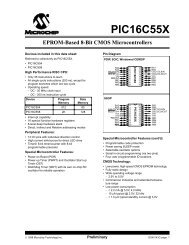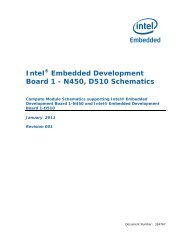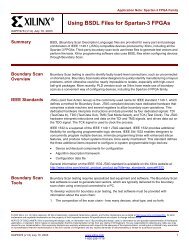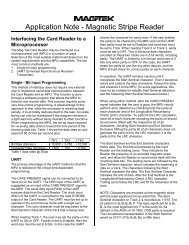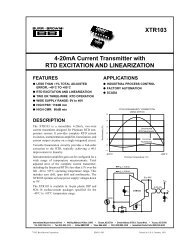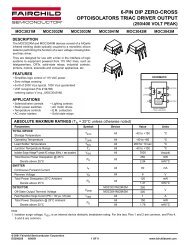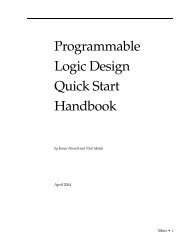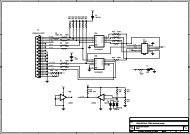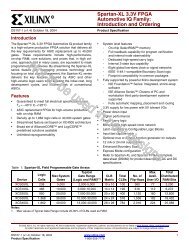3GPP TS
3GPP TS
3GPP TS
Create successful ePaper yourself
Turn your PDF publications into a flip-book with our unique Google optimized e-Paper software.
Release 199822<strong>3GPP</strong> <strong>TS</strong> 07.10 V7.2.0 (2002-03)5.4 Procedures and States5.4.1 DLC EstablishmentIn most cases the establishment of a DLC will be initiated by the TE, however, the protocol is balanced and theinitiation may come from the MS. The action taken by the higher layers of the TE upon the initiation of theestablishment of a DLC from the MS is outside the scope of the present document.The station wishing to establish a DLC transmits a SABM frame with the P-bit set to 1. The address field contains theDLCI value associated with the desired connection. If the responding station is ready to establish the connection it willreply with a UA frame with the F-bit set to 1. If the responding station is not ready or unwilling to establish theparticular DLC it will reply with a DM frame with the F-bit set to 1.Once a DLC has been established the stations are both said to be in a connected mode, for the particular DLC, andtransfer of information may commence.If no UA or DM response has been received after T1 the initiating station may retransmit the SABM. This action maybe repeated until a response is obtained or action is taken by a higher layer.If no negotiation procedure is used, DLC parameters are the default one.5.4.2 DLC ReleaseThe release of a DLC may be initiated by either station by the transmission of a DISC frame with the P-bit set to one.Confirmation of the DLC release is signalled by the other station sending a UA frame with the F-bit set to 1. Once theDLC has been released the stations enter disconnected mode for that particular DLC.If the station receiving the DISC command is already in a disconnected mode it will send a DM response.If no UA or DM response has been received after T1 the initiating station may retransmit the DISC. This action may berepeated until a response is obtained or action is taken by a higher layer.5.4.3 Information Transfer5.4.3.1 Information DataInformation is conveyed using UI or UIH frames. Support of UIH frames is mandatory and support of UI frames isoptional. UI frames are used when it is important to know that data received is correct. An example of the use of UIframes is in carrying IP (Internet Protocol) traffic where error recovery procedures are performed, if necessary, by ahigher layer. The use of UIH frames is appropriate if the link is not subject to errors. UI or UIH frames may also beused for data in situations where the delays inherent in error-recovery procedures are unacceptable, such as transmissionof voice data.The transmitter takes information from the convergence layer for the particular DLC and places it in the I-field of thetransmitted frame. Once a UI or UIH frame has been correctly received, the contents of its I-field is passed to theconvergence layer.The frames sent by the initiating station have the C/R bit set to 1 and those sent by the responding station have the C/Rbit set to 0. Both stations set the P-bit to 0.See subclause 5.2.1.2 for more details about C/R bitThe maximum length of the information field in UI or UIH frames shall be parameter N1 (see subclause 5.7.2).<strong>3GPP</strong>


